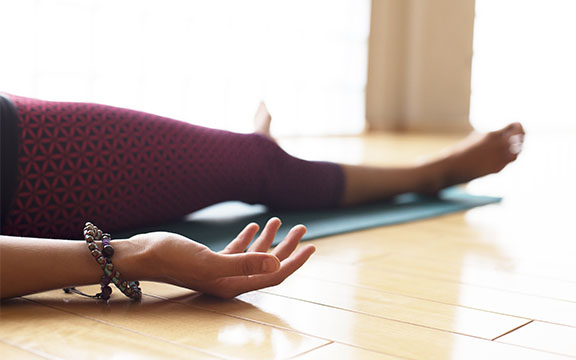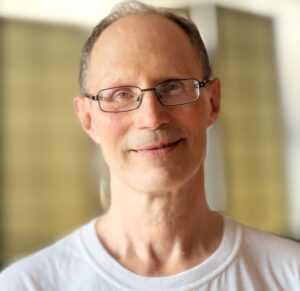
(Photo by Bill Geoghegan for Yogaville)
Many years ago, I took other types of Yoga but also just regular Integral Yoga Hatha classes. And I noticed whenever I left an Integral Yoga class, I just felt so incredible. Everything was moving in slow motion, I was floating and everything was totally clear. I was stunned. I was like, what is this? I did Hatha Yoga at home. I did it in other places and the postures were not making me feel this way. So I started to pay attention and I realized at some point that it was the Yoga Nidra.
Part of the reason I teach this is first of all, it just feels so good. I love it. It can make you feel so fantastic. Another piece is that it’s so accessible. People who have a lot of trouble sitting in formal meditation can do this practice and get a lot out of it. Any kind of yoga is a mind-body practice. To me, the idea that with your mind you can change your inner state so profoundly is really exciting. Although at a basic level we’re just talking about feeling good, you can actually make significant long-term changes in your life through this practice,
I’ve studied a number of different styles of Yoga Nidra. In a full Hatha Yoga class you wouldn’t have quite as much time. My classes are a little bit longer so I’m able to do a few more things. Everything I do is based on Integral Yoga Yoga Nidra but it’s more in-depth and extended than in a regular Hatha Yoga class. Sort of like Yoga Nidra on steroids.
There is a lot you can do with Yoga Nidra. You can incorporate many breathing practices and use intentions and a more elaborate sort of guided imagery. Different steps like opposites, things like heavy and light can be incorporated. Also, what they call the rotation of consciousness. In a Deep Relaxation class I can go into greater depth. In the rotation of consciousness, for example, we go through every single part of the body, all 60 points. You can just use simple relaxing imagery or that it’s a beautiful day. But you can also do very elaborate guided meditations. I try to be intuitive about what I’m feeling and what the students in class need. I also tend to be very attuned to the weather and the time. I find those are really powerful influences on your body and your state of mind, like the time change, winter solstice and cold weather. And I try to get inspired by what’s really happening right now in my own experience if I feel it’s an influence. Daylight Savings, for example, is a big shift in your whole energy level. That’s something I bring into the class or feelings related to Thanksgiving and holiday times.
You can do a lot with single states like happiness, contentment, and feeling safe. That’s really important because, first of all, for people to get the most out of this practice, they have to feel safe. They must feel secure just to be able to relax. (Yoga Nidra is also great for students coping with the effects of trauma). Then you are able to take them to some really deep places. I do a lot of things with emotions that express contentment and gratitude. I follow the basic format of the Integral Yoga practice, which is an awareness practice that goes through the five koshas or energetic layers.
People think of relaxation as just lying on the floor but it’s actually a very deep and powerful meditation practice that has many, many benefits. It’s also something you can work at. You can develop the ability to drop into these states very quickly and easily. It’s like a muscle. People might feel like they can’t measure results the way you see improvement in strength or stretches. They don’t feel like they are doing anything but the simplicity of the practice is deceptive and amazing. Some people really cannot relax or just let go. It’s very hard for some people. But it is a skill that you can develop. It is a form of meditation. It feels good, it’s relaxing but it can actually be a very deep form of spiritual practice for a serious meditator.
The practice of Yoga actually has some fairly profound effects on your brain chemistry. Most are probably short term. It stimulates your parasympathetic nervous system. It stimulates serotonin, which is known as the happy neurotransmitter. It stimulates GABA, which slows your thoughts down and helps you become calm. It stimulates oxytocin, another happy neurotransmitter. There are other things that it helps your brain with if you do it over time. For example, consolidation of memory. It can improve memory and be used as a repetitive learning technique during sleep when your brain is so relaxed and open that you can absorb a lot of information. It is also great for improving your sleep. It can also work with the two sides of the brain. There is a lot of research about how different parts of the brain can be accessed. If you have a stroke on one side, another side can take over some of the functions. Or for example, if you fracture your left arm and it’s in a cast and you exercise the same muscles on the right arm, you can maintain the muscle strength on the fractured side. There is a lot of new brain research that is amazing.
And our subconscious thinks in terms of imagery. You can use imagery to trigger deep subconscious memories and feelings. It can be like a cleansing where you break old patterns or emotional scars. People struggling with certain things emotionally for years can loosen them. It’s not like talk therapy; it’s subconscious. The imagery triggers deep held patterns of thought and allows you to process them. Sometimes people experience emotional reactions during this practice. They start crying or they’re very happy. I’m not saying that taking a 45-minute class will solve all your problems but over time it becomes almost like a yogic purification. These are all amazing things.
This practice is totally safe. You can’t physically hurt yourself because we’re not doing anything physical. It’s not a physical practice. That means that anybody, any age, as long as they are cognitively able, can do this practice, It can be done in a wheelchair or a bed. A lot of people afraid to try other Yoga classes would feel very comfortable doing this practice. And that’s another fantastic benefit for these people. Of course, most people just come because it’s relaxing and reduces stress and anxiety. There is nothing wrong with that, especially in this day and age when things are so intense now. It can also help with healing. Some of the neurotransmitters I mentioned are known to help with things like wound healing and managing pain. When you get into those deep states of relaxation the brainwaves change. Because your brain is so relaxed it’s easier for intentions to manifest. If you are recovering from surgery or an illness this can be very powerful. I’m not saying curing. I’m not making elaborate, crazy or unsubstantiated claims. I’m referring to the relaxation response that Herbert Benson wrote about. There is a lot of scientific research these days about the benefits of relaxation and meditation on the brain and body.
In today’s world, the country is collectively stressed out. During the COVID pandemic people were having mental health issues off the charts. During this time I think it is so important that people have this practice available in their tool chest. Again, I think that for a lot of people, it doesn’t seem like they’re doing anything. To pay money to take a special class just to do nothing doesn’t seem to make sense. But there is a lot that can be done with this practice.
Yoga Nidra is a perfect practice. Integral Yoga is a gentle approach that incorporates so many different things, awesome breathing, meditation, chanting, and of course, deep relaxation. So I think Yoga Nidra is a wonderful part of the total Yoga that is offered at the Integral Yoga Institute.
About the Author:
 Peter Karow is a long-time practitioner of Yoga and meditation. He is a Yoga Alliance certified Yoga teacher and is certified by the International Association of Yoga Therapists as a Yoga Therapist. He has taught at the Integral Yoga Institute New York City since 2010. In addition to his Yoga practice, he is a licensed Physical Therapist and a Health Care Administrator who has worked in Health Care Administration for many years. He has completed trainings in Yoga Therapy in Cancer and Chronic Illness (YCAT) and Therapeutic Yoga and has extensive training and experience teaching Yoga Nidra, a gentle guided meditation practice suitable for practitioners of all ages and experience levels. He is also a Certified Yoga for Arthritis and Pain instructor and particularly loves teaching these classes and helping students with pain and special needs. He has a special interest in yoga as a vehicle for self-knowledge, healing and inner balance.
Peter Karow is a long-time practitioner of Yoga and meditation. He is a Yoga Alliance certified Yoga teacher and is certified by the International Association of Yoga Therapists as a Yoga Therapist. He has taught at the Integral Yoga Institute New York City since 2010. In addition to his Yoga practice, he is a licensed Physical Therapist and a Health Care Administrator who has worked in Health Care Administration for many years. He has completed trainings in Yoga Therapy in Cancer and Chronic Illness (YCAT) and Therapeutic Yoga and has extensive training and experience teaching Yoga Nidra, a gentle guided meditation practice suitable for practitioners of all ages and experience levels. He is also a Certified Yoga for Arthritis and Pain instructor and particularly loves teaching these classes and helping students with pain and special needs. He has a special interest in yoga as a vehicle for self-knowledge, healing and inner balance.

